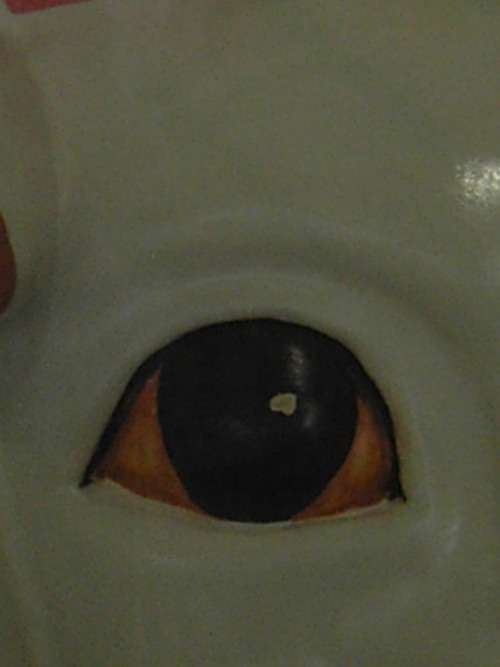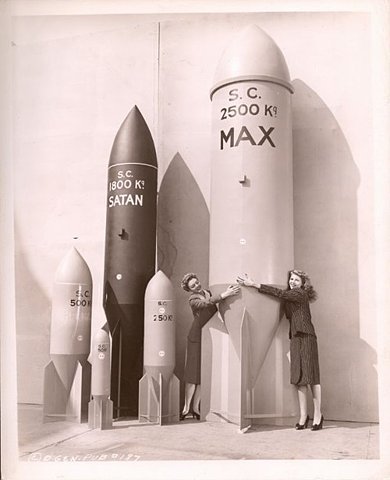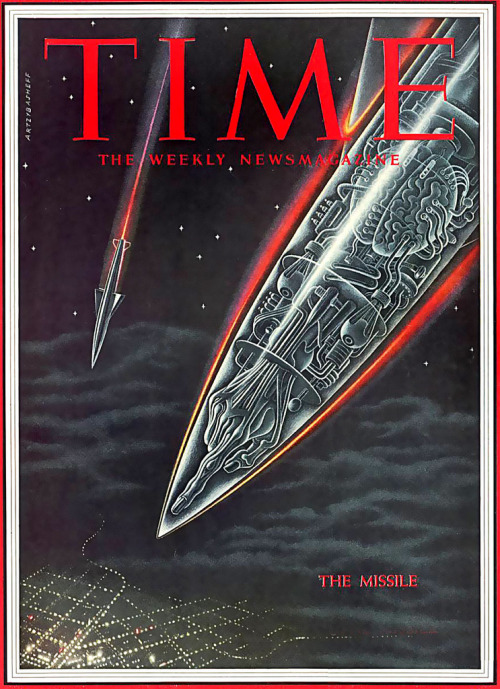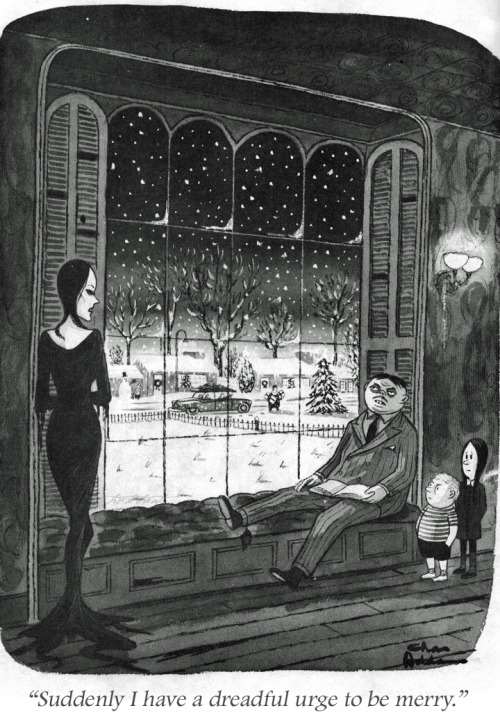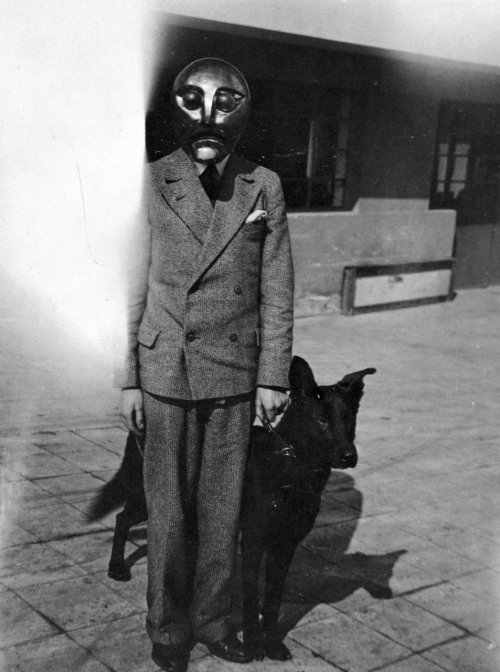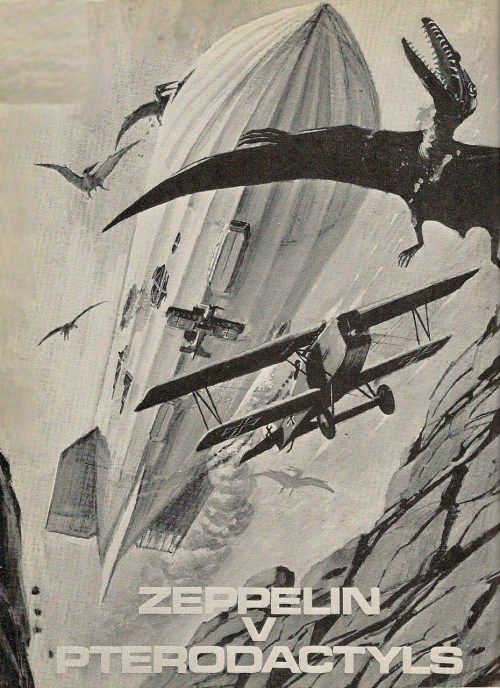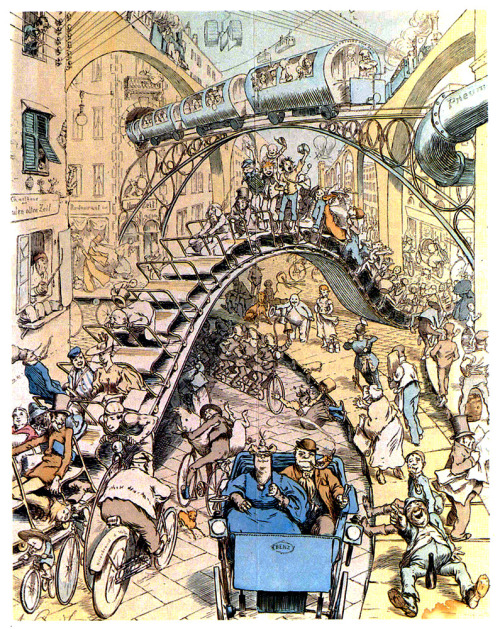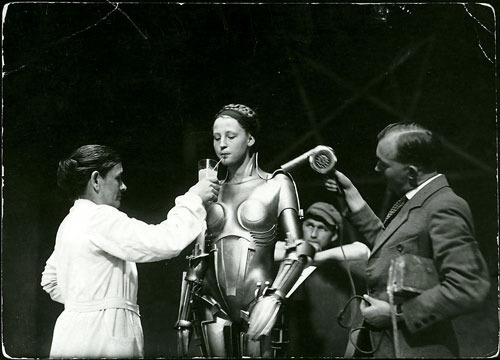
Friday, December 24, 2010
Dark Roasted Biscotti
Here's yet another of my takes on doing a Biscotti for the always-wonderful Dark Roasted Blend. I have to say these are a real kick and a treat to put together!
Thursday, December 23, 2010
Wednesday, December 22, 2010
Tuesday, December 21, 2010
Monday, December 20, 2010
Saturday, December 18, 2010
Wednesday, December 15, 2010
Tuesday, December 14, 2010
Neighbours
Wiki:
Neighbours (French title: Voisins) is a 1952 short film by Scottish-Canadian filmmaker Norman McLaren.
Produced at the National Film Board of Canada in Montreal, the film uses the technique known as pixilation, an animation technique using live actors as stop-motion objects. McLaren created the soundtrack of the film by scratching the edge of the film, creating various blobs, lines, and triangles which the projector read as sound.
Two men (Jean-Paul Ladouceur and Grant Munro) live peacefully side by side in houses made of cardboard, but when a flower blooms between both their houses, they fight each other to the death over the ownership of the single small flower.
Neighbours has garnered the label "one of the most controversial films the NFB ever made". Further, the eight-minute film was politically motivated:
"I was inspired to make Neighbours by a stay of almost a year in the People's Republic of China. Although I only saw the beginnings of Mao's revolution, my faith in human nature was reinvigorated by it. Then I came back to Quebec and the Korean War began. (...) I decided to make a really strong film about anti-militarism and against war." — Norman McLarenHowever, the version of Neighbours that ultimately won an Oscar was not the version McLaren had originally created. In order to make the film palatable for American and European audiences, McLaren was required to remove a scene in which the two men, fighting over the flower, murdered the other's wife and children.
During the Vietnam War, public opinion changed, and McLaren was asked to put the sequence back in. The original negative of that scene had been destroyed, so it was salvaged from a positive print of lower quality.
Monday, December 13, 2010
Sunday, December 12, 2010
Dark Roasted Weirdsville
Check it out: a brand new Dark Roasted Blend piece I did just went up: this time about building REALLY big things ... and I mean REALLY big things ....
As you remember in our last show we talked about how to add extra storage space to your continent by turning mountain ranges into bookcases, turning lakes into bath tubs, and continental shelfs into decks. Well, in this special episode of This Old World we're going to be taking the same approach but ramping it up a bit because, let's face it, even the best planet can only hold so many people. One day – though probably not anytime soon – all of us are going to need to do some serious expanding.
Back in the 1920s Herman Sörgel had the right idea, though on a pretty small scale. Herman's plan was to do a bit of tinkering with a rather tiny, almost insignificant, part of the earth: the Mediterranean Sea. Using readily available materials – though a lot of them – and technology he drew up plans to put a dam across the Straights of Gibraltar, and then to drain a large portion of the sea. The dam, he said, would provide power, and the radically lowered Mediterranean would give Europe and Africa a bountiful new spread of fertile land. Alas, Herman's Atlantropa never got off his drawing board but you have to admire his creativity – even if he didn't think big enough.
Christian Waldvogel, though, realized that if you're going to do some serious structural work it's better to overdo it than underdo it. Let's face it, if you’re going to tear down an old classic like the Earth you might as well get as much from it as you can. Waldvogel's idea was to take the planet, every bit of it, and reform it into what he called Globus Cassus: a massive hollow shell that humanity would live inside of, sunlight coming in through continent-sized windows. Since Globus Cassus would use all that wasted matter that otherwise is doing nothing but giving our little world gravity it would be much bigger, and with much more surface and living area than what we have now: imagine being on the inside of something the size of Jupiter. Since there'd be no gravity the people living inside would be held in place by inertia – what used to be called centrifugal force -- by giving the structure an appropriate amount of spin.
The obvious question is that if you're going to be a doing a bit of fixing-upping then why just stick with the Earth? There are plenty of other worlds in the solar system that are just sitting there, taking up space. Adding their mass to your plan opens up whole new opportunities to add some serious dimensions to your expansion.
One of the smallest of these is Larry Niven's legendary ringworld. The idea of rather simple: take most of the planets in the solar system, chew them up, and then turn them into a ring as long as Earth's orbit, as wide as the planet, with 1000 mile high edges to keep the air in. A ringworld would certainly give you lots of extra space – something on the order of three million earths – and, like Globus Cassus, it would be spun to make fake gravity. You could even make parts of it higher off the surface if you like your air a bit thinner, and if missed days and nights then you could put a row of black squares in an inner orbit to cast shadows.
No insult to Larry and his ringworld, though, it is on the smaller end of what you can do with a solar system if you really put your mind to it. Dan Alderson thought a bit bigger with his disc idea. Once again, all you need to do to create one is take every speck of matter in the solar system but instead of creating a ring you make a disc. Think a CD as thick as the earth's diameter – to make gravity – and with our sun in the center. If you like it warm you can get closer to that center and if you like it colder then step back a bit. If you miss the sunrises and sunsets then just bob the sun up and do so the folks on one side will get a bright day while the folks on the other will get a cooler night. And since the disc is as thick as the earth you don't need to worry about needing to fake gravity.
But, once again, we just aren't thinking big enough. Ponder the sun for a sec: isn't a lot of it being wasted on both a ringworld and a disc? Why not simply put a sphere around a sun to catch every little photon and, as a huge bonus, give you a lot of real estate to play with.
The also-legendary Freeman Dyson had the very same thought, thus the structure that bears his name: a Dyson Sphere. The only problem with a Dyson Sphere, aside from certain logistical headaches, is one of gravity as you can't do the same trick with a disc that you can do with a sphere. But that doesn't mean you couldn't just spin the sphere, giving folks on the inside an illusion of it – though if you walked too far up or down the inside there might be some very odd effects. If you really want to be ambitious, though, why not simply make the sphere as thick as the earth and have your population live on the outside? Light could be provided by a parade of fake suns powered by the real sun trapped inside the sphere under their feet.
Next week we'll discus how to add some serious space to your solar system by taking the idea of the Dyson sphere and ramping it up a bit. After all, if you can cage a star why not do the same to a solar system or even a galaxy?
The sky -- to dismiss the cliché -- is not the limit when it comes to planetary engineering.
As you remember in our last show we talked about how to add extra storage space to your continent by turning mountain ranges into bookcases, turning lakes into bath tubs, and continental shelfs into decks. Well, in this special episode of This Old World we're going to be taking the same approach but ramping it up a bit because, let's face it, even the best planet can only hold so many people. One day – though probably not anytime soon – all of us are going to need to do some serious expanding.
Back in the 1920s Herman Sörgel had the right idea, though on a pretty small scale. Herman's plan was to do a bit of tinkering with a rather tiny, almost insignificant, part of the earth: the Mediterranean Sea. Using readily available materials – though a lot of them – and technology he drew up plans to put a dam across the Straights of Gibraltar, and then to drain a large portion of the sea. The dam, he said, would provide power, and the radically lowered Mediterranean would give Europe and Africa a bountiful new spread of fertile land. Alas, Herman's Atlantropa never got off his drawing board but you have to admire his creativity – even if he didn't think big enough.
Christian Waldvogel, though, realized that if you're going to do some serious structural work it's better to overdo it than underdo it. Let's face it, if you’re going to tear down an old classic like the Earth you might as well get as much from it as you can. Waldvogel's idea was to take the planet, every bit of it, and reform it into what he called Globus Cassus: a massive hollow shell that humanity would live inside of, sunlight coming in through continent-sized windows. Since Globus Cassus would use all that wasted matter that otherwise is doing nothing but giving our little world gravity it would be much bigger, and with much more surface and living area than what we have now: imagine being on the inside of something the size of Jupiter. Since there'd be no gravity the people living inside would be held in place by inertia – what used to be called centrifugal force -- by giving the structure an appropriate amount of spin.
The obvious question is that if you're going to be a doing a bit of fixing-upping then why just stick with the Earth? There are plenty of other worlds in the solar system that are just sitting there, taking up space. Adding their mass to your plan opens up whole new opportunities to add some serious dimensions to your expansion.
One of the smallest of these is Larry Niven's legendary ringworld. The idea of rather simple: take most of the planets in the solar system, chew them up, and then turn them into a ring as long as Earth's orbit, as wide as the planet, with 1000 mile high edges to keep the air in. A ringworld would certainly give you lots of extra space – something on the order of three million earths – and, like Globus Cassus, it would be spun to make fake gravity. You could even make parts of it higher off the surface if you like your air a bit thinner, and if missed days and nights then you could put a row of black squares in an inner orbit to cast shadows.
No insult to Larry and his ringworld, though, it is on the smaller end of what you can do with a solar system if you really put your mind to it. Dan Alderson thought a bit bigger with his disc idea. Once again, all you need to do to create one is take every speck of matter in the solar system but instead of creating a ring you make a disc. Think a CD as thick as the earth's diameter – to make gravity – and with our sun in the center. If you like it warm you can get closer to that center and if you like it colder then step back a bit. If you miss the sunrises and sunsets then just bob the sun up and do so the folks on one side will get a bright day while the folks on the other will get a cooler night. And since the disc is as thick as the earth you don't need to worry about needing to fake gravity.
But, once again, we just aren't thinking big enough. Ponder the sun for a sec: isn't a lot of it being wasted on both a ringworld and a disc? Why not simply put a sphere around a sun to catch every little photon and, as a huge bonus, give you a lot of real estate to play with.
The also-legendary Freeman Dyson had the very same thought, thus the structure that bears his name: a Dyson Sphere. The only problem with a Dyson Sphere, aside from certain logistical headaches, is one of gravity as you can't do the same trick with a disc that you can do with a sphere. But that doesn't mean you couldn't just spin the sphere, giving folks on the inside an illusion of it – though if you walked too far up or down the inside there might be some very odd effects. If you really want to be ambitious, though, why not simply make the sphere as thick as the earth and have your population live on the outside? Light could be provided by a parade of fake suns powered by the real sun trapped inside the sphere under their feet.
Next week we'll discus how to add some serious space to your solar system by taking the idea of the Dyson sphere and ramping it up a bit. After all, if you can cage a star why not do the same to a solar system or even a galaxy?
The sky -- to dismiss the cliché -- is not the limit when it comes to planetary engineering.
Saturday, December 11, 2010
Friday, December 10, 2010
Dark Roasted Biscotti
Here's yet another of my takes on doing a Biscotti for the always-wonderful Dark Roasted Blend. I have to say these are a real kick and a treat to put together!
Tuesday, December 7, 2010
Monday, December 6, 2010
Saturday, December 4, 2010
Friday, December 3, 2010
Thursday, December 2, 2010
Wednesday, December 1, 2010
Monday, November 29, 2010
Friday, November 26, 2010
An Animated St. Trinian's
We're already talked about Ronald Searle's St. Trinian's. Well, here's a treat: an animation test based on Searle's style. Wonderful!
Monday, November 22, 2010
Dark Roasted Biscotti
Here's yet another of my takes on doing a Biscotti for the always-wonderful Dark Roasted Blend. I have to say these are a real kick and a treat to put together!
Tuesday, November 16, 2010
Monday, November 15, 2010
Sunday, November 14, 2010
Tuesday, November 9, 2010
Kit O'Connell Likes The Bachelor Machine
And The Bachelor Machine publicity continues! This one, though, is very special: a review by my great pal, Kit O'Connell, on the SF Review Site, about the first edition of The Bachelor Machine,. Kit also wrote a wonderful, and touching, forward to the new edition.
Justine is a high-priced hooker that is wired for a perverse but unique kind of thrill. Thanks to extensive implants and modifications (such as rerouting of arteries and internal oxygen tanks), she can have her throat slit by a client who can then fulfill necrophilic fantasies on a body that can wake up again, save them from criminal charges, and collect a hefty fee. In M. Christian's story "Everything But the Smell of Lilies," her pimp asks her to stage a distraction from a crime and act as a real victim, placing her in the hands of a paramedic with a taste for actual corpses. Suddenly, the difference between even a realistic simulation and the genuine article is brought into sharp focus. M. Christian relishes these kinds of subtle distinctions and moral conflicts, and they appear again and again in The Bachelor Machine, this widely published erotica author's first science fiction anthology.
In the last century, technology brought countless changes to human sexuality from the refinement of the vibrator to the invention of Viagra. Culturally, the ongoing revolution in the rights of women and gays in and out of the bedroom and the rise of the AIDS virus makes sex seem like at once a more wonderful and dangerous experience than ever before. It is surprising then that more science fiction writers do not speculate on the implications of tomorrow's technological and social innovations, but it is clear from The Bachelor Machine that Christian is not just well-traveled in this strange country but a native of the territory.
The author is not content to merely use the trappings of the genre to set up a cheap erotic thrill. Each story is relatively short, but the sex always relies on the technology and both exist to further the plot and development of character. In Christian's hands the kinkiest acts can be the sweetest, and the most vanilla of couplings can suddenly seem twisted."Eulogy" is set in a future where death is almost unheard of, and a consensual act of oral sex becomes repugnant when we learn that both partners are aware that the recipient of the act carries a rare and truly fatal sexually-transmitted disease.
The use of technology is equally deft. M. Christian clearly loves imagining new uses for implants, cybernetic augmentation, and wearable computing. In the haunting "Winged Memory," a prostitute wears 'whoreware,' which includes a bracelet that charges cash cards and eyewear that cycles from green to red when a client's time is up. Concepts like sexual orientation are turned on their ear in stories such as "Fully Accessorized, Baby," where two women make love with fully functional prosthetic penises and a cybernetic arm made of teak. Some partners lack gender entirely, as in the entirely cybernetic soldier and his equally machine partner who appear in "Skin-Effect."
The writing is at once skillfully sensual -- with sex that never becomes repetitive or boring -- and quick, direct, and razor-sharp enough to remind one of cyberpunk's finest moments. I never felt as though I was being lectured about the setting; instead we discover it directly through the eyes of each story's protagonist. Even the quickest and raunchiest of the stories resonate with deeper themes and subtle nuances that urge continued reflection and repeat readings. "Technophile" deserves to go down in history for bearing one of science fiction's immortal opening lines: "I almost lost my virginity at fifteen, but his batteries ran low;" it also displays both Christian's tender side and his sense of humor. This story concerns a young man who begins his first sexual explorations with a lover whose genitals are incompatible with the wiring in his home.
It is hard to pick out weaknesses in such a strong debut collection. A few stories suffer slightly from their brevity and would probably have been more effective as longer works. I also felt the collection was lacking in contextual information, such as a list of when and where stories first appeared in print; some are previously published and some appear here for the first time but there is no way to tell which is which. I'd also love it if the stories included some author's notes about the inspiration or ideas behind them, and the inclusion of the fascinating dialogue between Christian and Circlet Press' Cecilia Tan (an extra provided only to reviewers) would have further enhanced the volume.
The Bachelor Machine succeeds on every level as both erotica and speculative fiction; even the weakest entries entertain, shock, arouse, or amuse. If he continues writing in this vein, the author is sure to make waves within science fiction. With talent and vision to spare, M. Christian belongs on your reading list, too.
Monday, November 8, 2010
Sunday, November 7, 2010
Dark Roasted Biscotti
Here's another of my takes on doing a Biscotti for the always-wonderful Dark Roasted Blend. I have to say these are a real kick and a treat to put together!
Weirdsville On The Cud
Here's another special piece I did for the great folks at the Aussie site The Cud. This time it's about the brilliantly funny Brian G. Hughes.
"A Priest, A Rabbi, and A Minister Walk Into a Bar–"
What? You've heard that one? How about: "There once was a man from Nantucket–"
That one too? What about: "Yer Momma is so–"
Well, here's one who probably haven't ever heard, the one that starts: "There was this guy, named Brian G. Hughes..."
#
There was this guy, named Brian G. Hughes. He was an Einstein, a Salk, a Beethoven, a da Vinci – but he wasn't a physicist, a doctor, a composer, or a painter. He was, according to the society pages, a rather wealthy box manufacturer and a banker. But his genus wasn't in cardboard or playing the market.
New York around the turn of the previous century was a pretty dull berg, full of overly stuffed shirts and far-too-puffed-out egos. It was a dull place, a humorless place, a terribly stiff place – a city, and a society, that Brian G. Hughes saw as needing to be seriously goosed.
And goose it he did: with a flare and a flamboyance that shook New York from Battery Park to Queens. Take for instance the time he donated a plot of valuable Brooklyn real estate to the city, to be made into a public park. Great gesture, right? Fine civic spirit, correct? That's what the Board of Aldermen thought – until they actually took the time to check it out. See, the plot of land Brian G. Hughes had donated was only a two-by-six foot plot. Hey, he never said it would make a big park ...
Then there was the time he donated a mansion to a few well-respectable historical societies, one he claimed the Marquis de Lafayette had lived in during the War of Independence. "Wow" went the Ladies of those Historical Societies, "What a find." Until they checked out the real estate and discovered the mansion was actually a dilapidated flophouse in the Bronx. Seriously lacking in the giggle department, the ladies tried to have him committed. Now there was a hearing worth attending.
But real estate wasn't the only thing Hughes used in his pranks. For instance, he would routinely hang out in front of Tiffany's and drop boxes of fake jewels – just to watch people scramble to snatch up the supposed treasures. Another time he left a set of burglar tools out in front of a building. Nothing special in that, right? Well, the building was the Metropolitan Museum of Art, which prompted the – no doubt humorless – curator to close the entire landmark to frantically search for any missing paintings.
Love cats? Well, Mr. Hughes did – though he hated the pomposity of cat shows. One time he entered what he claimed was a spectacularly rare species. The whole of New York was buzzing about this feline masterpiece, and it even won a ribbon, though later on it was revealed that the cat, "Nicodemus, by Broomstick out of Dustpan by Sweeper, the last of the exotic Brindle breed," had actually been a common stray bought from a hobo.
Love horses? Well, Mr. Hughes ... I think you know where this might be going. His "Orphan Puldeca, out of Metropolitan by Electricity" thoroughly impressed the horse show crowd, until one sharper-than-average person figured out that "Orphan Puldeca" meant "Often Pulled the Car" and Hughes admitted that his entry was a noble example of a simple trolley horse.
Say you happened to be in a downtown establishment during, alas, a totally unexpected downpour. Why, look over there: a lovely – and apparently unclaimed – umbrella. It wouldn't be theft, you argue with yourself. You'll bring it right back, you conclude. Except that the instant you opened the umbrella, one of hundreds placed around the city, a banner would unfurl proclaiming that the bumbershoot had been STOLEN FROM BRIAN G. HUGHES.
While Mr. Hughes was, no doubt, a charming person to know it was best not to accept tickets from him as he was known to (tee-hee-hee) print up hundreds different ones to all kinds of events – which never existed.
Then, perhaps the capper to a wonderfully colorful career keeping the too-well-heeled on their toes and putting pepper up the noses of the upper-crusts, he announced that he – at considerable expense and at tremendous personal risk – would embark on an expedition to deepest and no-doubt darkest South American in pursuit of the elusive reetsa.
For weeks New York was on the edge of its manicured toes, gasping in excitement into its perfumed handkerchiefs, as word of the Hughes expedition was leaked out until, just as high society feared they could take no more, it was announced that Hughes would be returning to the island – with a living, breathing resets!
The city was aghast, the city was amazed, the city was riveted. By the thousands they came down to the docks to watch Hughes return, triumphant, from his perilous journey. Then, those crowds frozen in suspense, the ship arrived and Hughes made his triumphant appearance – with is captured reetsa...
There was this guy, named Brian G. Hughes, who convinced all of New York City that he'd traveled to South America to capture the mysterious reetsa – that turned out to be a simple farm animal, which he led down the gangplank backwards. Reetsa, naturally being "a steer" spelled backwards.
Here’s to you, Brian G. Hughes: the man who made an island laugh, a whole city giggle, who brought practical jokes to a whole new, and gloriously special, level: truly the last of a very special exotic brindle breed.
"A Priest, A Rabbi, and A Minister Walk Into a Bar–"
What? You've heard that one? How about: "There once was a man from Nantucket–"
That one too? What about: "Yer Momma is so–"
Well, here's one who probably haven't ever heard, the one that starts: "There was this guy, named Brian G. Hughes..."
#
There was this guy, named Brian G. Hughes. He was an Einstein, a Salk, a Beethoven, a da Vinci – but he wasn't a physicist, a doctor, a composer, or a painter. He was, according to the society pages, a rather wealthy box manufacturer and a banker. But his genus wasn't in cardboard or playing the market.
New York around the turn of the previous century was a pretty dull berg, full of overly stuffed shirts and far-too-puffed-out egos. It was a dull place, a humorless place, a terribly stiff place – a city, and a society, that Brian G. Hughes saw as needing to be seriously goosed.
And goose it he did: with a flare and a flamboyance that shook New York from Battery Park to Queens. Take for instance the time he donated a plot of valuable Brooklyn real estate to the city, to be made into a public park. Great gesture, right? Fine civic spirit, correct? That's what the Board of Aldermen thought – until they actually took the time to check it out. See, the plot of land Brian G. Hughes had donated was only a two-by-six foot plot. Hey, he never said it would make a big park ...
Then there was the time he donated a mansion to a few well-respectable historical societies, one he claimed the Marquis de Lafayette had lived in during the War of Independence. "Wow" went the Ladies of those Historical Societies, "What a find." Until they checked out the real estate and discovered the mansion was actually a dilapidated flophouse in the Bronx. Seriously lacking in the giggle department, the ladies tried to have him committed. Now there was a hearing worth attending.
But real estate wasn't the only thing Hughes used in his pranks. For instance, he would routinely hang out in front of Tiffany's and drop boxes of fake jewels – just to watch people scramble to snatch up the supposed treasures. Another time he left a set of burglar tools out in front of a building. Nothing special in that, right? Well, the building was the Metropolitan Museum of Art, which prompted the – no doubt humorless – curator to close the entire landmark to frantically search for any missing paintings.
Love cats? Well, Mr. Hughes did – though he hated the pomposity of cat shows. One time he entered what he claimed was a spectacularly rare species. The whole of New York was buzzing about this feline masterpiece, and it even won a ribbon, though later on it was revealed that the cat, "Nicodemus, by Broomstick out of Dustpan by Sweeper, the last of the exotic Brindle breed," had actually been a common stray bought from a hobo.
Love horses? Well, Mr. Hughes ... I think you know where this might be going. His "Orphan Puldeca, out of Metropolitan by Electricity" thoroughly impressed the horse show crowd, until one sharper-than-average person figured out that "Orphan Puldeca" meant "Often Pulled the Car" and Hughes admitted that his entry was a noble example of a simple trolley horse.
Say you happened to be in a downtown establishment during, alas, a totally unexpected downpour. Why, look over there: a lovely – and apparently unclaimed – umbrella. It wouldn't be theft, you argue with yourself. You'll bring it right back, you conclude. Except that the instant you opened the umbrella, one of hundreds placed around the city, a banner would unfurl proclaiming that the bumbershoot had been STOLEN FROM BRIAN G. HUGHES.
While Mr. Hughes was, no doubt, a charming person to know it was best not to accept tickets from him as he was known to (tee-hee-hee) print up hundreds different ones to all kinds of events – which never existed.
Then, perhaps the capper to a wonderfully colorful career keeping the too-well-heeled on their toes and putting pepper up the noses of the upper-crusts, he announced that he – at considerable expense and at tremendous personal risk – would embark on an expedition to deepest and no-doubt darkest South American in pursuit of the elusive reetsa.
For weeks New York was on the edge of its manicured toes, gasping in excitement into its perfumed handkerchiefs, as word of the Hughes expedition was leaked out until, just as high society feared they could take no more, it was announced that Hughes would be returning to the island – with a living, breathing resets!
The city was aghast, the city was amazed, the city was riveted. By the thousands they came down to the docks to watch Hughes return, triumphant, from his perilous journey. Then, those crowds frozen in suspense, the ship arrived and Hughes made his triumphant appearance – with is captured reetsa...
There was this guy, named Brian G. Hughes, who convinced all of New York City that he'd traveled to South America to capture the mysterious reetsa – that turned out to be a simple farm animal, which he led down the gangplank backwards. Reetsa, naturally being "a steer" spelled backwards.
Here’s to you, Brian G. Hughes: the man who made an island laugh, a whole city giggle, who brought practical jokes to a whole new, and gloriously special, level: truly the last of a very special exotic brindle breed.
Saturday, November 6, 2010
Wednesday, November 3, 2010
Tuesday, November 2, 2010
Monday, November 1, 2010
Sunday, October 31, 2010
Smile!

A visitor takes picture of a sculpture “Nude No. 2” by China’s artist Mu Boyan
at the Hong Kong International Art Fair in Hong Kong Wednesday, May 13, 2009. (AP Photo/Kin Cheung)
Saturday, October 30, 2010
And Each Room Has A Picture of Hitler!
Wiki:
Prora is a beach resort on the island of Rügen, Germany, known especially for its colossal Nazi-planned touristic structures. The massive building complex was built between 1936 and 1939 as a Kraft durch Freude (KdF) project. The eight buildings are identical, and while they were planned as a holiday locale, they were never used for this purpose. The complex has a formal heritage listing as a particularly striking example of Third Reich architecture.
Prora is an extensive bay between the Sassnitz and Binz regions, near Prorer Wiek, on the narrow heath (called the Prora) which separates the Jasmunder Bodden from the Baltic Sea. The buildings extend over a length of 4.5 km and are roughly 150 m from the beach. The coast offers a long flat sand beach, which stretches from Binz to the Fährhafen. This beach was thus an ideal location for the establishment of a seaside resort.
Dr. Robert Ley envisioned Prora as a parallel to Butlins - British "holiday camps" designed to provide affordable holidays for the average worker. Prora was designed to house 20,000 holidaymakers, under the ideal that every worker deserved a holiday at the beach. Designed by Clemens Klotz (1886-1969), all rooms were planned to overlook the sea. Each room of 5 by 2.5 metres (16'5" x 8'3") was to have two beds, an armoire (wardrobe) and a sink. There were communal toilets and showers.
Hitler's plans for Prora were much more ambitious. He wanted a gigantic sea resort, the "most mighty and large one to ever have existed", holding 20,000 beds. In the middle, a massive building was to be erected. At the same time, Hitler wanted it to be convertible into a military hospital in case of war. Hitler insisted that the plans of a massive indoor arena by architect Erich Putlitz be included. Putlitz's Festival Hall was intended to be able to accommodate all 20,000 guests at the same time. His plans included two wave-swimming pools and a theatre. A large dock for passenger ships was also planned.
In late 2008, plans were approved to have Prora fill its original purpose and to turn it into a modern tourist resort. The council set out plans to build enough living space to house 3000 people, as well as a youth hostel, and amenities for tourists. Kerstin Kassner, a local counciller, compared Prora's shore with a "Caribbean beach." However, the decision met with some skepticism from Binz locals, who felt that there were already too many tourists in the region, and Heike Tagsold, a Prora historian, who said that the town's past made it an inappropriate location for tourists.
Friday, October 29, 2010
Out Now: THE BACHELOR MACHINE By M.Christian
THE BACHELOR MACHINE
Science Fiction Erotica
A Brand New Edition
Out Now From M.Christian!
Science Fiction Erotica
A Brand New Edition
Out Now From M.Christian!
M.Christian and Circlet Press are proud to announce the publication of a brand new edition of M.Christian's best-selling and ground-breaking collection of science fiction erotica: The Bachelor Machine!
Now available in ebook for the first time, 18 short stories of crackling erotic futures by the master of erotic voice, M. Christian. Men, women, hackers, derelicts, enforcers, hustlers, and whores in every combination inhabit the streets and beds and back alleys of Christian's imagination. This is erotic science fiction at its best.
Included in this new edition, in addition to Cecilia Tan's rave introduction to M.Christian's work from the original book, is a special foreword by Kit O'Connell, a chat between Cecilia Tan and M.Christian on mixing science fiction and erotica, and much more!
I’m going to tell you a secret. There are only two people in the world I envy. One is the late Roger Zelazny, whose talent for an almost jazz improvisational way of writing I could never match.The other is M. Christian, for writing exactly what I’d write if only I could get off my ass. Which is to say, raunchy hallucinatory sexfuture dreams that never fail to arouse me and kick me in the gut at the same time ...
- Cecilia Tan, from her original introduction
In the years since I first read The Bachelor Machine, I've shared these thought-provoking tales with many friends. The stories have never failed to provoke both reaction and discussion. Long after arousal is gone, there are stories here that haunt me. I'm glad that now you can share that too ...
- Kit O'Connell, from his foreword to the new edition
The stories in his new collection, The Bachelor Machine, pass the litmus tests of both the SF and erotica genres. Take out the tech and there’s no story; take out the sex and there’s no story. This description may lead those unfamiliar with SF erotica to suspect that every story is about getting off with the aid of futuristic technologies, and that’s true as far as it goes. But that’s not going nearly far enough. The stories in The Bachelor Machine are not about sex, though they’re stuffed with sexual acts; the stories are about what sex means. M.Christian is writing about the psychology of being human, and he often does so by exploring sexual possibilities and realities that are rarely discussed, even in private conversation. He not only thinks forbidden thoughts, he extrapolates them in the finest SF fashion ...
- Cynthia Ward, Locus On-line
- Cecilia Tan, from her original introduction
In the years since I first read The Bachelor Machine, I've shared these thought-provoking tales with many friends. The stories have never failed to provoke both reaction and discussion. Long after arousal is gone, there are stories here that haunt me. I'm glad that now you can share that too ...
- Kit O'Connell, from his foreword to the new edition
The stories in his new collection, The Bachelor Machine, pass the litmus tests of both the SF and erotica genres. Take out the tech and there’s no story; take out the sex and there’s no story. This description may lead those unfamiliar with SF erotica to suspect that every story is about getting off with the aid of futuristic technologies, and that’s true as far as it goes. But that’s not going nearly far enough. The stories in The Bachelor Machine are not about sex, though they’re stuffed with sexual acts; the stories are about what sex means. M.Christian is writing about the psychology of being human, and he often does so by exploring sexual possibilities and realities that are rarely discussed, even in private conversation. He not only thinks forbidden thoughts, he extrapolates them in the finest SF fashion ...
- Cynthia Ward, Locus On-line
As a special treat, here's an interview with M.Christian from the Suicide Girl's Web site about The Bachelor Machine!
And The Bachelor Machine has its own Wikipedia page!
Here's what others are saying about M.Christian and The Bachelor Machine:
M.Christian speaks with a totally unique and truly fascinating voice. There are a lot of writers out there who'd better protect their markets!
- Mike Resnick, Hugo and Nebula Award-winning science fiction author
M.Christian's stories squat at the intersection of Primal Urges Avenue and Hi-Tech Parkway like a feral-eyed, half-naked Karen Black leering and stabbing her fractal machete into the tarmac. Portraying a world where erotic life has spilled from the bedroom into the street, and been shattered into a million sharp shards, these tales undercut and mutate the old verities concerning memory, desire and loyalty. Truly an author for our post-everything 21st century.
- Paul Di Filippo, author of The Steampunk Trilogy, and reviewer for Issac Asimov's Science Fiction Magazine.
Fantasist, futurist, eroticist, satirist, humorist, dentist drilling deep into the nerves of the here and now ... M. Christian wears a lot of hats in this multifaceted collection, and they're all a splendid fit.
- Brian Hodge, author of Mad Dogs and Lies & Ugliness
M. Christian is the chameleon of modern erotica. One day punk, another romantic; one day straight, another totally perverse and polyamorous. But always sexy and gripping.
- Maxim Jakubowksi, editor of the Mammoth Book of Erotica series
M. Christian is a chimera, an amazing combination of tour guide and magician. Whether he's writing science fiction, horror, or erotica, he can take you to places you've never imagined, show you sights no-one else will get to see, introduce you to some fascinating people, and guarantee that the trip will be memorable from start to finish. Buy a ticket and fasten your seat belt: you're in for a wild ride!
- Stephen Dedman, author of The Art of Arrow Cutting, and Shadows Bite
M. Christian always writes like a dream whether he's creating fantastic visions or ghastly nightmares. With this collection, you get both!
- Paula Guran, DarkEcho
Jump into the slipstream of The Bachelor Machine and M.Christian will take you for a joyride - down into the places where nanoseconds seem to last an eternity and the orgasms are as big as Jupiter. Strap yourself on his rocket ship of soaring prose and fantastic plot, where your co-pilots have any gender, all gender and whose mission is to leave you breathless with desire and safely exhausted with satiation. Let The Bachelor Machine speed you on your way ...
- William Dean, Clean Sheets
- Mike Resnick, Hugo and Nebula Award-winning science fiction author
M.Christian's stories squat at the intersection of Primal Urges Avenue and Hi-Tech Parkway like a feral-eyed, half-naked Karen Black leering and stabbing her fractal machete into the tarmac. Portraying a world where erotic life has spilled from the bedroom into the street, and been shattered into a million sharp shards, these tales undercut and mutate the old verities concerning memory, desire and loyalty. Truly an author for our post-everything 21st century.
- Paul Di Filippo, author of The Steampunk Trilogy, and reviewer for Issac Asimov's Science Fiction Magazine.
Fantasist, futurist, eroticist, satirist, humorist, dentist drilling deep into the nerves of the here and now ... M. Christian wears a lot of hats in this multifaceted collection, and they're all a splendid fit.
- Brian Hodge, author of Mad Dogs and Lies & Ugliness
M. Christian is the chameleon of modern erotica. One day punk, another romantic; one day straight, another totally perverse and polyamorous. But always sexy and gripping.
- Maxim Jakubowksi, editor of the Mammoth Book of Erotica series
M. Christian is a chimera, an amazing combination of tour guide and magician. Whether he's writing science fiction, horror, or erotica, he can take you to places you've never imagined, show you sights no-one else will get to see, introduce you to some fascinating people, and guarantee that the trip will be memorable from start to finish. Buy a ticket and fasten your seat belt: you're in for a wild ride!
- Stephen Dedman, author of The Art of Arrow Cutting, and Shadows Bite
M. Christian always writes like a dream whether he's creating fantastic visions or ghastly nightmares. With this collection, you get both!
- Paula Guran, DarkEcho
Jump into the slipstream of The Bachelor Machine and M.Christian will take you for a joyride - down into the places where nanoseconds seem to last an eternity and the orgasms are as big as Jupiter. Strap yourself on his rocket ship of soaring prose and fantastic plot, where your co-pilots have any gender, all gender and whose mission is to leave you breathless with desire and safely exhausted with satiation. Let The Bachelor Machine speed you on your way ...
- William Dean, Clean Sheets
About M.Christian:
M.Christian is - among many things - an acknowledged master of erotica with more than 300 stories in such anthologies as Best American Erotica, Best Gay Erotica, Best Lesbian Erotica, Best Bisexual Erotica, Best Fetish Erotica, and many, many other anthologies, magazines, and Web sites. He is the editor of 25 anthologies including the Best S/M Erotica series, The Burning Pen, Guilty Pleasures, The Mammoth Book of Future Cops and The Mammoth Book of Tales of the Road (with Maxim Jakubowksi) and Confessions, Garden of Perverse, and Amazons (with Sage Vivant) as well as many others. He is the author of the collections Dirty Words, Speaking Parts, Licks & Promises, Filthy, Love Without Gun Control, Rude Mechanicals, and Coming Together Presents M.Christian; and the novels Running Dry, The Very Bloody Marys, Me2, Brushes, and Painted Doll.
The Bachelor Machine
Circlet Press
ASIN: B003Y8XUK2
ebook/Kindle Edition
$7.99
Please contact M.Christian at zobop@aol.com for a review copy
Thursday, October 28, 2010
Wednesday, October 27, 2010
Tuesday, October 26, 2010
Saturday, October 23, 2010
Dark Roasted Biscotti
Here's another of my takes on doing a Biscotti for the always-wonderful Dark Roasted Blend. I have to say these are a real kick and a treat to put together!
Tuesday, October 19, 2010
Monday, October 18, 2010
Dark Roasted Weirdsville
Check it out: a brand new Dark Roasted Blend piece I did just went up: this time about old typewriters - especially the marvelous Malling-Hansen: The Writing Ball.

Horse and buggies, hoop skirts, steam engines, bustles ... oh, yes, life around the turn of the previous century was a delight of simplicity and workmanship. But that doesn't mean that the artisans and engineers of way-back-when didn’t at least have their hearts and minds in the right place.
Take, for example, what writing used to be like before a few very bright bulbs thought to create machines to make it easier: pens that constantly ran dry, ink that spilled or smeared, illegible handwriting ... getting the message across -- any message across -- by hand was problematic at best, totally confusing at worst.
One of the earliest of those bright bulbs was William Austin Burt who, in 1829, created what he called a 'typewritor.' If Burt's machine was the first is a matter of much debate as another, similar, machine had also built by Pellegrino Turri around the same time. Some even say the crown of 'first' should go to Henry Mill, who created a writing machine way back in 1714.
But all of these devices were just baby steps: more potential than actually being helpful to people whose job it was to be clear, concise and fast with their writing. There were a lot of others after them these early pioneers, but none of them were ever a real commercial success. Looking at them you can see why: in many of these very early models – called 'index typewriters,' by the way – the typing was done by selecting the letter to be used on a slider and then pressing it against the paper. To call these early monsters 'slow' is being kind. Changing the alphabetical slider to a disc version helped a bit but not enough to make any of these machines easy or popular.
In 1865, what many consider to be the true ancestor to the first true, efficient, and financially successful was developed by Rasmus Malling-Hansen: The Writing Ball. What's fascinating about Hansen's creation isn't just its efficiency but also it's strangely elegant beauty. Just look at it: a brass half-sphere covered with keys above a cylinder that held the paper. It was finely made, unlike some of the unsuccessful machines before it, looking more like a gentleman's watch than a piece of office equipment.
Sure, Hansen's Ball has some rather serious flaws – like the fact that it was hardly cheap and, because of the position of the ball and the paper under it, the typist really couldn't see what they were typing until they were done and the paper was removed from the machine -- but that didn't stop it from selling better than many other previous models. One quirk of the ball was that, unlike the QWERTY keyboard that pretty much every typewriter after it and every computer after those typewriters became extinct had, the ball's keys had been positioned to make typing easier for the typist and not the typewriter. By the way, in case you don't know the sad, strange story of QWERTY – which haunts us to this day -- the alphabet were originally put in that order because otherwise users would type faster than the machine could handle, thus jamming the keys. So QWERTY was created to keep that from happening: to keep the machine happy at the cost of typist efficiency.

Here's a fun bit of trivia for you folks now interested in Malling-Hansen's elegant writing ball: one particular person was interested in this new, wondrous invention – a celebrated writer who was having a hard time with his diminishing eyesight. While Nietzsche did get and use his writing ball he sadly didn't love it – though it is fascinating to visualize the author of Thus Spoke Zarathustra clicking and clacking on the mechanical beauty of one of Hansen's creations.
Eventually, though, other – and cheaper – machines were developed, saving generations of writers, secretaries, business people, and anyone else who used to have to put pen to paper, from cramp and bad handwriting. Though Hansen and his elegant ball have been almost lost to time it's nice to be able to show a new, QWERTY-slaved generation, the beauty of his creation.


Horse and buggies, hoop skirts, steam engines, bustles ... oh, yes, life around the turn of the previous century was a delight of simplicity and workmanship. But that doesn't mean that the artisans and engineers of way-back-when didn’t at least have their hearts and minds in the right place.
Take, for example, what writing used to be like before a few very bright bulbs thought to create machines to make it easier: pens that constantly ran dry, ink that spilled or smeared, illegible handwriting ... getting the message across -- any message across -- by hand was problematic at best, totally confusing at worst.
One of the earliest of those bright bulbs was William Austin Burt who, in 1829, created what he called a 'typewritor.' If Burt's machine was the first is a matter of much debate as another, similar, machine had also built by Pellegrino Turri around the same time. Some even say the crown of 'first' should go to Henry Mill, who created a writing machine way back in 1714.
But all of these devices were just baby steps: more potential than actually being helpful to people whose job it was to be clear, concise and fast with their writing. There were a lot of others after them these early pioneers, but none of them were ever a real commercial success. Looking at them you can see why: in many of these very early models – called 'index typewriters,' by the way – the typing was done by selecting the letter to be used on a slider and then pressing it against the paper. To call these early monsters 'slow' is being kind. Changing the alphabetical slider to a disc version helped a bit but not enough to make any of these machines easy or popular.
In 1865, what many consider to be the true ancestor to the first true, efficient, and financially successful was developed by Rasmus Malling-Hansen: The Writing Ball. What's fascinating about Hansen's creation isn't just its efficiency but also it's strangely elegant beauty. Just look at it: a brass half-sphere covered with keys above a cylinder that held the paper. It was finely made, unlike some of the unsuccessful machines before it, looking more like a gentleman's watch than a piece of office equipment.
Sure, Hansen's Ball has some rather serious flaws – like the fact that it was hardly cheap and, because of the position of the ball and the paper under it, the typist really couldn't see what they were typing until they were done and the paper was removed from the machine -- but that didn't stop it from selling better than many other previous models. One quirk of the ball was that, unlike the QWERTY keyboard that pretty much every typewriter after it and every computer after those typewriters became extinct had, the ball's keys had been positioned to make typing easier for the typist and not the typewriter. By the way, in case you don't know the sad, strange story of QWERTY – which haunts us to this day -- the alphabet were originally put in that order because otherwise users would type faster than the machine could handle, thus jamming the keys. So QWERTY was created to keep that from happening: to keep the machine happy at the cost of typist efficiency.

Here's a fun bit of trivia for you folks now interested in Malling-Hansen's elegant writing ball: one particular person was interested in this new, wondrous invention – a celebrated writer who was having a hard time with his diminishing eyesight. While Nietzsche did get and use his writing ball he sadly didn't love it – though it is fascinating to visualize the author of Thus Spoke Zarathustra clicking and clacking on the mechanical beauty of one of Hansen's creations.
Eventually, though, other – and cheaper – machines were developed, saving generations of writers, secretaries, business people, and anyone else who used to have to put pen to paper, from cramp and bad handwriting. Though Hansen and his elegant ball have been almost lost to time it's nice to be able to show a new, QWERTY-slaved generation, the beauty of his creation.

Saturday, October 16, 2010
Friday, October 15, 2010
Wednesday, October 13, 2010
Tuesday, October 12, 2010
Weirdsville On The Cud
Here's another special piece I did for the great folks at the Aussie site The Cud. This time it's about the incredible Felix von Luckner, the The Benevolent Sea-Devil.
The year: 1917, the height of the War To End All Wars, sadly now referred to as World War 1. The Place: The Atlantic Ocean. You: the captain of an allied merchant ship carrying coal from Cardiff to Buenos Aires.
Then, like a ghost from the distant past, a ship appears: a beautiful three mastered windjammer flying a Norwegian flag. Staggered by this hauntingly lovely anachronism you think nothing of it coming alongside – it was common, after all, for friendly ships to want to synchronize their chronometers – until, that is, the ship's Norwegian flag is quickly replaced by the German eagle and the captain, in amazingly polite terms, backed up by guns that have mysteriously appeared in the windjammer's gunwales, explains that your ship is now his.
And so you have been captured by the Seeadler ("Sea Eagle" in German), captained by Felix von Luckner, or, as he was known by both enemies as all as allies, the Benevolent Sea-Devil.
Some people's lives are so broad, so wild, so amazing that they simply don't seem real. The stuff of Saturday matinees? Sure. But real, authentic and true? Never! But if even half of Felix von Luckner's life is true – and there's no reason to really doubt any of it – then he was truly a broad, wild, and utterly amazing fellow.
Born in 1881, in Dresden, Felix ran away from home at 13. Stowing away on a Russian trawler, he fell overboard – rescued, so the story goes, by grabbing hold of an albatross, the bird's flapping wings acting as a signal to a rescue party.
Making his way to Australia, Felix tried a number of – to put it politely – odd jobs: boxer, circus acrobat, bartender, fisherman, lighthouse keeper (until discovered with the daughter of a hotel owner), railway worker, kangaroo hunter, and even had a stint in the Mexican army. During all this Felix also became a notable magician and a favorite entertainer to no less than Kaiser Wilhelm himself.

Making his way back to Germany he passed his navigation exams and served aboard a steamer before getting called to serve in the Navy on the SMS Panther.
Which brings us to that War That Was Supposedly The End To All Wars. Even though it was fought with steel and oil, the German's outfitted a number of older ships as raiders -- hidden guns, more powerful engines and the like – and sent them out to harass allied shipping. Most of them were, to put it politely, a failure. But then there was the Seeadler, under the command of Felix von Luckner.
During the course of the war Felix sank or captured no less that 16 ships – a staggering amount. What’s even more staggering is how Felix did it, and that he did it with grace, honor, and even a certain kindness. You see, while the Seeadler took out those ships it, during it's entire campaign, did it at the cost of only single human life. Most of the time the scenario went just as it did with your merchant ship carrying coal from Cardiff to Buenos Aries: the Seeadler would approach a target, raise it's German eagle and that would be that: the crew and cargo would be captured and the ship scuttled. Sometimes she'd fire a shot to two to get her pint across that she was serious, but it wasn't until the British ship, Horngarth, that anyone had actually been killed. Tricked into thinking they were investigating a stricken ship – Felix had actually used a smoke generator – the captured Horngarth had refused to stop broadcasting a distress signal. A single shot took out the radio but unfortunately killed the operator. Felix von Luckner, though, gave the man a full military funeral at sea and even went as far as to write the poor man's family telling them that he had died with honor.
To give you even more evidence that Felix von Luckner more than deserved the "benevolent" in his "Benevolent Sea-Devil" nickname he treated everyone he captured with dignity and respect: captured sailors were paid for their time while on his ship and officers ate with him at his captain's table. When the Seeadler got too packed with prisoners, by this time more than 300, Felix captured the Cambronne, a little French ship, cut down her masts and let all his prisoners go with the understanding that if they happened to get picked up before making land they wouldn't tell where the Seeadler was going.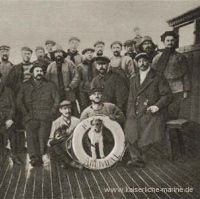 Respecting Felix's honor they didn't.
Respecting Felix's honor they didn't.
Alas, the Seeadler's rule of the Atlantic had to end sometime – but even that just adds to the broad, wild, and utterly amazing life of Felix von Luckner. With the British – and now the Americans – hot on her tail, Felix decided to take a quick barnacle-scraping break from piracy by putting the Seeadler into a bay on Mopelia, a tiny coral atoll. Now stories here conflict a bit – Felix always claimed that a rogue tsunami was to blame – but I think the more-standard explanation that the crew and prisoners of the Sealer were simply having a picnic on the island when their windjammer drifted aground.
Taking a few of his men in some long boats, Felix sailed off towards Fiji intending to steal a ship and come back for the Seeadler. Through a series of incredible adventures – including claiming to be Dutch-Americans crossing the Atlantic on a bet – the Sea-Devil was himself tricked into surrendering by the Fijian police who threatened, after becoming suspicious of one of Felix's stories, to sink his boat with an actually-unarmed ferry. By the way, the remaining crew and prisoners of the Seeadler had their own adventures, leading eventually to the escape of the prisoners and the capturing of the Seeadler's crew.
But even a Chilean prison camp wasn't the end for Felix, or not quite the end. Using the cover of putting on a Christmas play, he and several other prisoners managed to steal the warden's motorboat and then seize a merchant ship. Alas, Felix's luck ran out when they were captured again and spent the rest of the war being moved from one camp to another.
But rest assured the story doesn't end there. Far from it: after writing a book about his various adventures, Felix von Luckner toured the world entertaining audiences about the Seeadler – as well as demonstrating his strength by tearing phone books in half and bending coins between thumb and forefinger.
Far from it: after writing a book about his various adventures, Felix von Luckner toured the world entertaining audiences about the Seeadler – as well as demonstrating his strength by tearing phone books in half and bending coins between thumb and forefinger.
While, with the rise of Hitler, some people thought of Felix as a apologist, the captain had no love for the Nazi's – especially since the German government had frozen his assets when he refused to renounce the honorary citizenships and honors he'd received during his travels.
But the story of Felix von Luckner still isn't over. Retiring to the German town of Halle, he was asked by the mayor to negotiate the town's surrender to the Americans. While he did this, earning not only the respect of the Americans and the gratitude of the citizens, his reward from the Nazi's was to be sentenced to death. Luckily, Felix managed to flee to Sweden where he lived until passing away at the age of 84.
War is horror, war is pointless death, and war is needless suffering. But because of men like Felix von Luckner, war can also show the good, noble side of man – and that some men can remarkably earn the respect of friend and enemy alike.
The year: 1917, the height of the War To End All Wars, sadly now referred to as World War 1. The Place: The Atlantic Ocean. You: the captain of an allied merchant ship carrying coal from Cardiff to Buenos Aires.
Then, like a ghost from the distant past, a ship appears: a beautiful three mastered windjammer flying a Norwegian flag. Staggered by this hauntingly lovely anachronism you think nothing of it coming alongside – it was common, after all, for friendly ships to want to synchronize their chronometers – until, that is, the ship's Norwegian flag is quickly replaced by the German eagle and the captain, in amazingly polite terms, backed up by guns that have mysteriously appeared in the windjammer's gunwales, explains that your ship is now his.

And so you have been captured by the Seeadler ("Sea Eagle" in German), captained by Felix von Luckner, or, as he was known by both enemies as all as allies, the Benevolent Sea-Devil.
Some people's lives are so broad, so wild, so amazing that they simply don't seem real. The stuff of Saturday matinees? Sure. But real, authentic and true? Never! But if even half of Felix von Luckner's life is true – and there's no reason to really doubt any of it – then he was truly a broad, wild, and utterly amazing fellow.
Born in 1881, in Dresden, Felix ran away from home at 13. Stowing away on a Russian trawler, he fell overboard – rescued, so the story goes, by grabbing hold of an albatross, the bird's flapping wings acting as a signal to a rescue party.
Making his way to Australia, Felix tried a number of – to put it politely – odd jobs: boxer, circus acrobat, bartender, fisherman, lighthouse keeper (until discovered with the daughter of a hotel owner), railway worker, kangaroo hunter, and even had a stint in the Mexican army. During all this Felix also became a notable magician and a favorite entertainer to no less than Kaiser Wilhelm himself.

Making his way back to Germany he passed his navigation exams and served aboard a steamer before getting called to serve in the Navy on the SMS Panther.
Which brings us to that War That Was Supposedly The End To All Wars. Even though it was fought with steel and oil, the German's outfitted a number of older ships as raiders -- hidden guns, more powerful engines and the like – and sent them out to harass allied shipping. Most of them were, to put it politely, a failure. But then there was the Seeadler, under the command of Felix von Luckner.
During the course of the war Felix sank or captured no less that 16 ships – a staggering amount. What’s even more staggering is how Felix did it, and that he did it with grace, honor, and even a certain kindness. You see, while the Seeadler took out those ships it, during it's entire campaign, did it at the cost of only single human life. Most of the time the scenario went just as it did with your merchant ship carrying coal from Cardiff to Buenos Aries: the Seeadler would approach a target, raise it's German eagle and that would be that: the crew and cargo would be captured and the ship scuttled. Sometimes she'd fire a shot to two to get her pint across that she was serious, but it wasn't until the British ship, Horngarth, that anyone had actually been killed. Tricked into thinking they were investigating a stricken ship – Felix had actually used a smoke generator – the captured Horngarth had refused to stop broadcasting a distress signal. A single shot took out the radio but unfortunately killed the operator. Felix von Luckner, though, gave the man a full military funeral at sea and even went as far as to write the poor man's family telling them that he had died with honor.
To give you even more evidence that Felix von Luckner more than deserved the "benevolent" in his "Benevolent Sea-Devil" nickname he treated everyone he captured with dignity and respect: captured sailors were paid for their time while on his ship and officers ate with him at his captain's table. When the Seeadler got too packed with prisoners, by this time more than 300, Felix captured the Cambronne, a little French ship, cut down her masts and let all his prisoners go with the understanding that if they happened to get picked up before making land they wouldn't tell where the Seeadler was going.
 Respecting Felix's honor they didn't.
Respecting Felix's honor they didn't.Alas, the Seeadler's rule of the Atlantic had to end sometime – but even that just adds to the broad, wild, and utterly amazing life of Felix von Luckner. With the British – and now the Americans – hot on her tail, Felix decided to take a quick barnacle-scraping break from piracy by putting the Seeadler into a bay on Mopelia, a tiny coral atoll. Now stories here conflict a bit – Felix always claimed that a rogue tsunami was to blame – but I think the more-standard explanation that the crew and prisoners of the Sealer were simply having a picnic on the island when their windjammer drifted aground.
Taking a few of his men in some long boats, Felix sailed off towards Fiji intending to steal a ship and come back for the Seeadler. Through a series of incredible adventures – including claiming to be Dutch-Americans crossing the Atlantic on a bet – the Sea-Devil was himself tricked into surrendering by the Fijian police who threatened, after becoming suspicious of one of Felix's stories, to sink his boat with an actually-unarmed ferry. By the way, the remaining crew and prisoners of the Seeadler had their own adventures, leading eventually to the escape of the prisoners and the capturing of the Seeadler's crew.
But even a Chilean prison camp wasn't the end for Felix, or not quite the end. Using the cover of putting on a Christmas play, he and several other prisoners managed to steal the warden's motorboat and then seize a merchant ship. Alas, Felix's luck ran out when they were captured again and spent the rest of the war being moved from one camp to another.
But rest assured the story doesn't end there.
 Far from it: after writing a book about his various adventures, Felix von Luckner toured the world entertaining audiences about the Seeadler – as well as demonstrating his strength by tearing phone books in half and bending coins between thumb and forefinger.
Far from it: after writing a book about his various adventures, Felix von Luckner toured the world entertaining audiences about the Seeadler – as well as demonstrating his strength by tearing phone books in half and bending coins between thumb and forefinger.While, with the rise of Hitler, some people thought of Felix as a apologist, the captain had no love for the Nazi's – especially since the German government had frozen his assets when he refused to renounce the honorary citizenships and honors he'd received during his travels.
But the story of Felix von Luckner still isn't over. Retiring to the German town of Halle, he was asked by the mayor to negotiate the town's surrender to the Americans. While he did this, earning not only the respect of the Americans and the gratitude of the citizens, his reward from the Nazi's was to be sentenced to death. Luckily, Felix managed to flee to Sweden where he lived until passing away at the age of 84.
War is horror, war is pointless death, and war is needless suffering. But because of men like Felix von Luckner, war can also show the good, noble side of man – and that some men can remarkably earn the respect of friend and enemy alike.
Subscribe to:
Comments (Atom)
